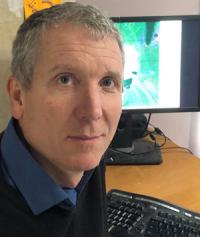The team has been awarded 10 million euros for an interdisciplinary, collaborative project on the structural and biophysical analysis of selected photoreceptors and their development into ‘OptoGPCRs’, light-controlled molecular switches with a wide range of applications in biology and medicine. The ERC Synergy Grant team members are former HFSP grant recipients Gebhard Schertler (Paul Scherrer Institut, Switzerland), who acts as corresponding principal investigator, and Robert Lucas (University of Manchester, UK) with colleagues Peter Hegemann (Humboldt University of Berlin, Germany) and Sonja Kleinlogel (University of Bern, Switzerland). Together they will demonstrate how OptoGPCRs can revolutionise our ability to control a wide variety of complex cellular processes with light.
The project funded by the ERC Synergy Grant ‘Switchable rhodOpsins in Life Sciences’ – SOL – is based on so-called bistable rhodopsins, which belong to the class of G protein coupled receptors (GPCRs). There are hundreds of different GPCRs activating a variety of different G proteins, and they play an important role in cell signalling in almost every cell type. Not surprisingly, they are the targets of a large variety of pharmaceuticals. Rhodopsins are light-activated GPCRs, best known for their role as light receptors in the retina of the human eye. Upon activation, the vision receptors in our eyes lose their light sensor, the vitamin A derivative retinal, and it must be ‘reassembled’ to accept photons (light) again. Bistable rhodopsins, however, keep their retinal and can, in principle, be activated and deactivated by multiple flashes of light without requiring any assembly, acting as true biological ‘switches’.
Using light to switch a cellular process on and off
"Our consortium pursues three main goals," says Gebhard Schertler. "First, we want to elucidate the structure of the bistable rhodopsins in order to better understand how they function."
Second, the researchers will use molecular biological methods to create bistable rhodopsins with novel properties that can be turned on and off by light of different wavelengths and effectively mimic the signalling effect of other GPCRs.
"This will enable us to turn any G protein-mediated signalling process in any cell type on and off by light of a specific colour," Schertler explains. “Our third goal is to use these switches to study the effect of G protein signalling in animals and to use this knowledge for the development of gene therapeutics against human diseases.”
The second optogenetics revolution
The conception of the first generation of optogenetics introduced a revolutionary idea in modern life sciences and provided an outstanding example of how basic research on molecular properties of proteins can translate into a practical application in cellular and animal systems. Optogenetics has already made an enormous impact in neurosciences. Up to now, however, it has been limited to light-gated ion channels, restricting its application essentially to the stimulation of nerve cells. This has prevented widespread application of this technology in the life sciences. So far, attempts to extend the range of optogenetic tools towards the photo-control of cellular receptors such as GPCR have failed. The combined synergistic and interdisciplinary expertise of Gebhard Schertler, an expert in structural characterisation of these receptors, Peter Hegemann, a founding father of the first optogenetic tools with an unmatched knowledge in biophysical characterisation of photoreceptors, Robert Lucas, a world-leading expert on bistable rhodopsins in mammals and an expert in cellular assays, and Sonja Kleinlogel, a pioneer in gene therapy using optogenetics, will provide the opportunity to deliver a toolbox of light-controlled cellular receptors with widespread applications in biology and medicine.
The HFSP grant of Gebhard Schertler, Robert Lucas and Akihisa Terakita of Osaka City University in Japan laid the groundwork for this project by aiming to identify suitable GPCR-based photo-receptors for the development of optogenetic tools. A major focus was on invertebrate photo-receptors, which at the time were poorly understood systems. The HFSP grant was an essential driver for the ERC application and provided important preliminary data, which were critical for the ERC Synergy Grant application.
| “Only HFSP gives researchers the opportunity to form a global team of experts with synergistic expertise pursuing truly high-risk projects,” says Schertler. "As frequently demonstrated in the past, these pioneering ‘moonshot' projects have the potential to pave the way for transformative developments in the life sciences. I am very grateful for my HFSP grants as they are among the few opportunities supporting global cooperation and providing the necessary amount of freedom needed to pursue a truly novel direction in science." |
Text by Sebastian Jutzi and Gregor Cicchetti (Paul Scherrer Institute)
|
|
ETH Zurich Professor Gebhard Schertler is Head of the Division of Biology and Chemistry and member of the directorial board of the Paul Scherrer Institute (PSI), Switzerland. He received his PhD from the University of Munich, where he started to build his expertise in the structural biology of membrane proteins and molecular pharmacology. From 1989 until 2009, he was at the MRC-LMB in Cambridge, UK, first as a Long-Term EMBO fellow, then as a staff scientist, and eventually as group leader. Gebhard Schertler is a world leader in the structural biology of membrane proteins with expertise in biophysical methods, X-ray imaging, electron microscopy, and X-ray crystallography including time-resolved measurements with synchrotrons and free electron lasers. He initiated the Free Electron Laser biology research program at PSI and was a member on the scientific advisory committee of the MAX IV Laboratory, Sweden. His experience translating research results into business opportunities includes being a scientific founder of MRC-LMB Spin-Off Heptares Ltd., as well as being a co-founder and scientific advisor of InterAx AG and leadXpro AG, two Swiss Biotech companies. Gebhard Schertler is the recipient of three HFSP grants, and his 2014 grant on 'Adapting metazoan opsins for optogenetic applications' was instrumental for the recently awarded ERC Synergy grant 'Switchable rhodOpsins in Life Sciences'. |
| Robert Lucas is Professor of Neuroscience and Director of the Centre for Biological Timing at the University of Manchester. He completed his PhD in anatomy at the University of London in 1997 and held a lectureship at Imperial College London before moving to Manchester in 2003. In 2014, he was awarded an HFSP Program Grant, together with Gebhard Schertler and Akihisa Terakita, to study metazoan opsins. |  |



































